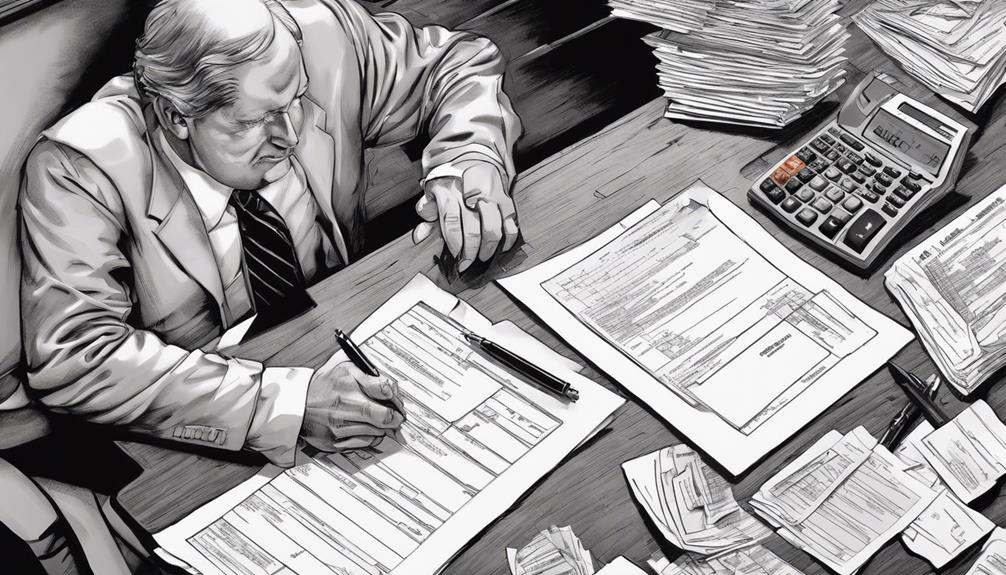Navigating the complexities of divorce can be incredibly challenging. However, what if there was a way to simplify the process with five simple steps, allowing for the possibility of an uncontested divorce?
By following these strategic guidelines, couples can pave the way towards a swift resolution that minimizes conflict and streamlines the legal proceedings. Let's explore how these steps can pave the way for a more harmonious separation.
Key Takeaways
- Meet residency and agreement requirements for mutual consent.
- Complete accurate divorce forms detailing assets, custody, and finances.
- File paperwork correctly with the county court and proof of service.
- Finalize through a prove-up hearing after a 60-day waiting period.
Understanding Uncontested Divorce Process
When embarking on the journey of an uncontested divorce in Texas, it's crucial to understand the streamlined court process that hinges on mutual agreement between both parties. In this simplified process, the spouses must come to an agreement on key aspects such as child custody, property division, and support. To initiate the divorce proceedings, specific forms required by the court need to be filled out and filed. This method of divorce can often save time and money compared to a contested divorce due to the absence of court hearings and prolonged legal battles.
For an uncontested divorce to proceed smoothly in Texas, both parties must meet the state's residency requirements and concur on the grounds for divorce. The final step in this process involves attending a prove-up hearing, where the spouses appear before the court to finalize the divorce decree. This hearing typically takes place after a 60-day waiting period, marking the official conclusion of the uncontested divorce proceedings.
Meeting Residency and Agreement Requirements

Meeting the residency and agreement requirements is crucial for a successful uncontested divorce in Texas. To ensure a smooth process, here are some essential steps to consider:
- Residency Requirements: Meeting Texas's residency requirements is paramount. This entails living in Texas for at least 6 months and in the specific county for the previous 90 days.
- Mutual Agreement on Insupportability: Both parties must agree on the reason for divorce, typically citing insupportability. This mutual agreement lays the foundation for an uncontested divorce.
- Agreeing on All Issues: It's vital to reach a consensus on various matters such as property division, debts, child custody, and support. Resolving these issues amicably is key to a successful uncontested divorce in Texas.
Completing Uncontested Divorce Forms
To streamline the uncontested divorce process in Texas, completing the necessary divorce forms accurately and thoroughly is a critical initial step. These forms, which include the Petition for Divorce, Waiver of Service, Final Decree of Divorce, and other required documents, play a crucial role in outlining key details such as asset division, child custody arrangements, and financial disclosures. Ensuring the accuracy of these details is paramount to prevent delays or complications in the proceedings. Forms can be acquired from various sources like the Texas Law Help website, online divorce services, or the local county courthouse. Below is a helpful table summarizing the key aspects to consider when completing uncontested divorce forms in Texas:
| Aspect | Importance | Source |
|---|---|---|
| Asset Division | Critical for fair distribution of property and finances | Texas Law Help website |
| Child Custody Arrangements | Essential for outlining parental responsibilities and rights | Online divorce services |
| Financial Disclosures | Necessary for transparency in financial matters | County courthouse |
Filing Uncontested Divorce Paperwork

Let's ensure all necessary divorce forms are accurately completed and signed by both spouses before proceeding with filing. Here are some vital steps to follow when filing your uncontested divorce paperwork:
- Double-Check Texas Legal Requirements: Review the completed forms to ensure they meet all Texas Family Law requirements for an uncontested divorce. Accuracy is crucial to avoid potential delays in the process.
- Submit to the Court: Once the paperwork is ready, submit the forms to the appropriate county court along with the required filing fees. Ensuring everything is in order will help expedite the legal process.
- Provide Proof of Service: Notify your spouse of the divorce filing by providing proof of service. This step is essential to keep all parties informed and maintain transparency throughout the proceedings.
Finalizing Your Uncontested Divorce
Commencing the finalization of an uncontested divorce in Texas typically involves attending a prove-up hearing to present the agreed-upon terms to the judge. At this crucial stage, both parties affirm their voluntary agreement to the divorce settlement terms. The judge meticulously reviews the case to ensure all legal requirements are met before confirming the divorce. One key aspect to note is that Texas law mandates a 60-day waiting period before issuing the final divorce decree in uncontested cases. This waiting period allows for any necessary adjustments or considerations before the divorce becomes official.
Finalizing an uncontested divorce signifies the conclusion of the marriage in a streamlined manner, sparing both parties from lengthy court proceedings. It's a significant step that solidifies the agreed-upon terms and brings closure to the legal process. The judge's confirmation during the prove-up hearing marks the ultimate validation of the voluntary agreement and paves the way for the issuance of the final divorce decree.
Frequently Asked Questions
How Long Does Uncontested Divorce Take in Texas?
An uncontested divorce in Texas typically takes about three to six months to finalize. The mandatory 60-day waiting period before the final decree is granted contributes to this timeline. Cooperation between parties can expedite the process.
Can You Get a Divorce in Texas Without Going to Court?
Yes, in Texas, it's possible to get a divorce without going to court if both spouses agree on all terms. This streamlined process, available for uncontested cases, allows couples to finalize their divorce without a court appearance.
How Can I Get a Quick Divorce in California?
We can get a quick divorce in California by agreeing on all terms, such as property division and child custody. The process takes at least 6 months due to a mandatory waiting period after serving divorce papers.
How Much Does a Simple Divorce Cost in Texas?
In Texas, the cost of a simple uncontested divorce typically ranges from $300 to $500 in filing fees. Additional expenses for online services and mediation can increase the total cost. Uncontested divorces are generally more cost-effective.
Conclusion
In conclusion, getting an uncontested divorce in Texas is a straightforward process if both parties can agree on the terms.
It's ironic how something as significant as ending a marriage can be resolved so smoothly with the right approach.
By following the steps outlined, couples can part ways amicably and move forward with their lives in a cost-effective and efficient manner.









